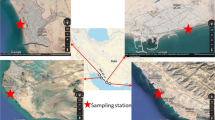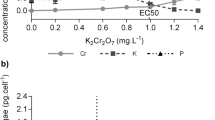Abstract
The levels of Cd, Cu, Pb, and Zn were determined in the commonest species of green, red, and brown algae collected from five coastal sites in south-western Sardinia (Italy), an area with a long history of mining and smelting. The usefulness of employing Enteromorpha sp. and Padina pavonica (L.) Thivy to monitor metal pollution was evaluated, while diffusive gradients in thin films (DGT) devices were used to measure dissolved metals in seawater. Levels of Cd and Pb were high enough to be of environmental concern in the whole study area. A significant relationship was found between the content of Pb in P. pavonica and DGT-labile Pb in seawater, suggesting that gross elemental concentrations of nonessential metals such as Pb in algal tissues are apparently controlled by the abundance of dissolved metal species in the ambient seawater. The results pointed out the usefulness of using both DGT and algal methods for a better understanding of trace metal availability in coastal waters.
Similar content being viewed by others
References
Al-Masri, M. S., Mamish, S. & Budier, Y (2003). Radionuclides and trace metals in eastern Mediterranean Sea algae. Journal of Environmental Radioactivity, 67, 157–168.
Amado Filho, G. M., Andrade, L. R., Karez, C. S., Farina, M. & Pfeiffer, W. C (1999). Brown algae species as biomonitors of Zn and Cd at Sepetiba Bay, Rio de Janeiro, Brazil. Marine Environmental Research, 48, 213–224.
Barreiro, R., Picado, L. & Real, C (2002). Biomonitoring heavy metals in estuaries: A field comparison of two brown algae species inhabiting upper estuarine reaches. Environmental Monitoring and Assessment, 75(2), 121–134.
Boni, M., Costabile, S., De Vivo, B., & Gasparrini, M. (1999). Potential environmental hazard in the mining district of southern Iglesiente (SW Sardinia, Italy). Journal of Geochemical Exploration, 67, 417–430.
Brown, M. T., & Depledge, M. H. (1998). Determination of trace metal concentrations in marine organisms. In: W. J. Langston & M. J. Bebianno (Eds.), Metal metabolism in aquatic environments (pp. 185–217). London: Chapman & Hall.
Brown, M. T., Hodgkinson, W. M., & Hurd, C. L. (1999). Spatial and temporal variations in the copper and zinc concentrations of two green seaweeds from Otago Harbour, New Zealand. Marine Environmental Research, 47, 175–184.
Bryan, G. W., Langston, W. J., Hummerstone, L. G., & Burt, G. R. (1985). A guide to the assessment of heavy metal contamination in estuaries using biological indicators. Occasional Publications. Marine Biological Association of the United Kingdom, 4, 1–92.
Campanella, L., Conti, M. E., Cubadda, F., & Sucapane, C. (2001). Trace metals in seagrass, algae and molluscs from an uncontaminated area in the Mediterranean. Environmental Pollution, 111, 117–126.
Conti, M. E., & Cecchetti, G. (2003). A biomonitoring study: Trace metals in algae and molluscs from Tyrrhenian coastal areas. Environmental Research, 93, 99–112.
Crist, R. H., Oberholser, K., McGarrity, J., Crist, D. R., Johnson, J. K., & Brittsan, J. M. (1992). Interaction of metals and protons with algae. 3. Marine algae, with emphasis on lead and aluminium. Environmental Science and Technology, 26, 496–502.
Daka, E. R. (2005). Heavy metal concentrations in Littorina saxatilis and Enteromorpha intestinalis from Manx Estuaries. Marine Pollution Bulletin, 50, 1433–1456.
Davison, W., Zhang, H. (1994). In situ speciation measurements of trace components in natural waters using thin film gels. Nature, 367, 546–548.
Fergusson, J. E. (1990). Heavy elements, chemistry, environmental impact and health effects. Oxford UK: Pergamon.
Haritonidis, S., & Malea, P. (1999). Bioaccumulation of metals by the green alga Ulva rigida from Thermaikos Gulf, Greece. Environmental Pollution, 104(3), 365–372.
Hashim, M. A., & Chu, K. H. (2004). Biosorption of cadmium by brown, green, and red seaweeds. Chemical Engineering Journal, 97(2–3), 249–255.
Ho, Y. (1987). Metals in 19 intertidal macroalgae in Hong Kong waters. Marine Pollution Bulletin, 18, 564–566.
Leal, M. C., Vasconcelos, M. T., Souza-Pinto, I., & Cabral, J. P. S. (1997). Biomonitoring with benthic magroalgae and direct assay of heavy metals in seawater of the Oporto coast (northwest Portugal). Marine Pollution Bulletin, 34(12), 1006–1015.
Li, W., Zhao, H., Teasdale, P. R., John, R., & Wang, F. (2005). Metal speciation measurement by diffusive gradients in thin films technique with different binding phases. Analytica Chimica Acta, 533, 193–202.
Lobban, C. S., & Harrison, P. J. (1994). Seaweed ecology and physiology. New York: Cambridge University Press.
Millot, C. (1999). Circulation in the Western Mediterranean Sea. Journal of Marine Systems, 20(1–4), 423–442.
Muse, J. O., Carducci, C. N., Stripeikis, J. D., Tudino, M. B., & Fernandez, F. M. (2006). A link between lead and cadmium kinetic speciation in seawater and accumulation by the green alga Ulva lactuca. Environmental Pollution, 141, 126–130
Pérez, A. A., Farías, S. S., Strobl, A. M., Pérez, L. B., López, C. M., Piñeiro, A., et al. (2007). Levels of essential and toxic elements in Porphyra columbina and Ulva sp. from San Jorge Gulf, Patagonia Argentina. Science of Total Environment, 376, 51–59.
Phillips, D. J. H. (1977). The use of biological indicator organisms to monitor trace metal pollution in marine and estuarine environments—A review. Environmental Pollution, 13, 281–31.
Phillips, D. J. H. (1994). Macrophytes as biomonitors of trace metals. In: K. I. M. Kramer (Ed.), Biomonitor of coastal waters and estuaries (pp. 85–103). Boca Raton: CRC.
Rainbow, P. S. (1995). Biomonitoring of heavy metal availability in the marine environment. Marine Pollution Bulletin, 31(4–12), 183–192.
Sanchez-Rodriguez, I., Huerta-Diaz, M. A., Choumiline, E., Holguin-Quinones, O., & Zertuche-Gonzalez, J. A. (2001). Elemental concentrations in different species of seaweeds from Loreto Bay, Baja California Sur, Mexico: Implications for the geochemical control of metals in algal tissue. Environmental Pollution, 114, 145–160.
Sawidis, T., Brown, M. T., Zachariadis, G., & Sratis, I. (2001). Trace metal concentrations in marine macroalgae from different biotopes in the Aegean Sea. Environmental International, 27, 43–47.
Schintu, M., & Degetto, S. (1999). Sedimentary record of heavy metals in the industrial harbour of Portovesme, Sardinia (Italy). Science of Total Environment, 241, 129–141.
Schintu, M., Durante, L., Maccioni, A., Meloni, P., Degetto, S., & Contu, A. (2008). Measurement of environmental trace-metal levels in Mediterranean coastal areas with transplanted mussels and DGT techniques. Marine Pollution Bulletin, 57(6–12), 832–837.
Scoullos, M., Plavšić, M., Karavoltsosa, S., & Sakellaria, A. (2006). Partitioning and distribution of dissolved copper, cadmium and organic matter in Mediterranean marine coastal areas: The case of a mucilage event. Estuarine, Coastal and Shelf Science, 67(3), 484–490.
Storelli, M. M., Storelli, A., & Marcotrigiano, G. O. (2001). Heavy metals in the aquatic environment of the Southern Adriatic Sea, Italy. Macroalgae, sediments and benthic species. Environmental International, 26, 505–509.
Sunda, W. G., & Guillard, R. R. L. (1976). The relationship between cupric ion activity and the toxicity of copper to phytoplankton. Journal of Marine Research, 34, 511–529.
Tusseau-Vuillemin, M. H., Gilbin, R., & Taillefert, M. (2003). A dynamic numerical model to characterize labile metal complexes collected with diffusion gradient in thin films devices. Environmental Science & Technology, 37(8), 1645–1652.
Twiss, M. R., & Moffet, J. W. (2002). Comparison of copper speciation in coastal marine waters measured using analytical voltammetry and diffusion gradient in thin-film techniques. Environmental Science and Technology, 36, 1061–1068.
Volesky, B. & Holan, Z. H. (1995). Biosorption of heavy metals. Biotechnology Progress, 11, 235–250.
Zbikowski, R., Szefer, P., & Latala, A. (2006). Distribution and relationships between selected chemical elements in green alga Enteromorpha sp. from the southern Baltic. Environmental Pollution, 143, 435–448.
Zhang, H., & Davison, W. (1995). Performance characteristics of diffusion gradients in thin films for the in situ measurement of trace metals in aqueous solutions. Analytical Chemistry, 67, 3391–3400.
Zhang, H., & Davison, W. (1999). Diffusional characteristics of hydrogels used in DGT and DET techniques. Analytica Chimica Acta, 398, 329–340.
Zhang, H., & Davison, W. (2000). Direct in situ measurements of labile inorganic and organically bound metal species in synthetic solutions and natural waters using diffusive gradients in thin films. Analytical Chemistry, 72, 4447–4457.
Author information
Authors and Affiliations
Corresponding author
Rights and permissions
About this article
Cite this article
Schintu, M., Marras, B., Durante, L. et al. Macroalgae and DGT as indicators of available trace metals in marine coastal waters near a lead–zinc smelter. Environ Monit Assess 167, 653–661 (2010). https://doi.org/10.1007/s10661-009-1081-8
Received:
Accepted:
Published:
Issue Date:
DOI: https://doi.org/10.1007/s10661-009-1081-8




